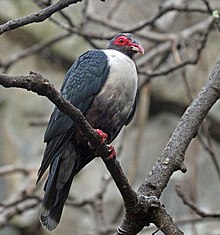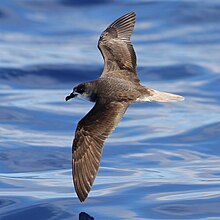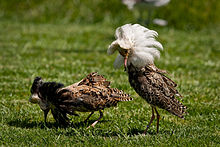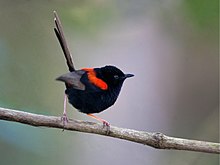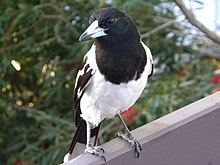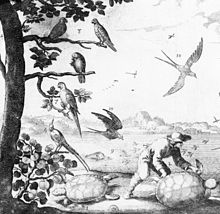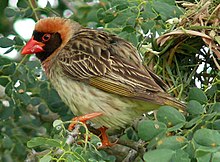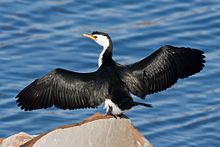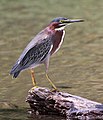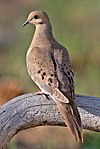Portal:Birds
The Birds Portal

Birds are a group of warm-blooded vertebrates constituting the class Aves (/ˈeɪviːz/), characterised by feathers, toothless beaked jaws, the laying of hard-shelled eggs, a high metabolic rate, a four-chambered heart, and a strong yet lightweight skeleton. Birds live worldwide and range in size from the 5.5 cm (2.2 in) bee hummingbird to the 2.8 m (9 ft 2 in) common ostrich. There are over 11,000 living species, more than half of which are passerine, or "perching" birds. Birds have wings whose development varies according to species; the only known groups without wings are the extinct moa and elephant birds. Wings, which are modified forelimbs, gave birds the ability to fly, although further evolution has led to the loss of flight in some birds, including ratites, penguins, and diverse endemic island species. The digestive and respiratory systems of birds are also uniquely adapted for flight. Some bird species of aquatic environments, particularly seabirds and some waterbirds, have further evolved for swimming. The study of birds is called ornithology.
Birds are feathered theropod dinosaurs and constitute the only known living dinosaurs. Likewise, birds are considered reptiles in the modern cladistic sense of the term, and their closest living relatives are the crocodilians. Birds are descendants of the primitive avialans (whose members include Archaeopteryx) which first appeared during the Late Jurassic. According to recent estimates, modern birds (Neornithes) evolved in the Late Cretaceous and diversified dramatically around the time of the Cretaceous–Paleogene extinction event 66 million years ago, which killed off the pterosaurs and all non-avian dinosaurs.
Many social species pass on knowledge across generations, which is considered a form of culture. Birds are social, communicating with visual signals, calls, and songs, and participating in such behaviours as cooperative breeding and hunting, flocking, and mobbing of predators. The vast majority of bird species are socially (but not necessarily sexually) monogamous, usually for one breeding season at a time, sometimes for years, and rarely for life. Other species have breeding systems that are polygynous (one male with many females) or, rarely, polyandrous (one female with many males). Birds produce offspring by laying eggs which are fertilised through sexual reproduction. They are usually laid in a nest and incubated by the parents. Most birds have an extended period of parental care after hatching.
Many species of birds are economically important as food for human consumption and raw material in manufacturing, with domesticated and undomesticated birds being important sources of eggs, meat, and feathers. Songbirds, parrots, and other species are popular as pets. Guano (bird excrement) is harvested for use as a fertiliser. Birds figure throughout human culture. About 120 to 130 species have become extinct due to human activity since the 17th century, and hundreds more before then. Human activity threatens about 1,200 bird species with extinction, though efforts are underway to protect them. Recreational birdwatching is an important part of the ecotourism industry. (Full article...)
Featured articles
-
Mountain pigeons are four species of birds in the genus Gymnophaps in the pigeon family Columbidae. They are found on islands in eastern Indonesia and Melanesia, where they inhabit hill and montane forest. Medium-sized pigeons with long tails and wings, they are 33–38.5 cm (13.0–15.2 in) long and weigh 259–385 g (9.1–13.6 oz). They mostly have dull grey, white, or chestnut-brown plumage, their most distinctive feature being bright red skin around the eyes. Males and females mostly look alike, but the Papuan and pale mountain pigeons show slight sexual dimorphism. Mountain pigeons are very social and are usually seen in flocks of 10–40 birds, although some species can form flocks of more than 100 individuals. They are generally quiet and do not make many vocalisations apart from a distinctive whooshing noise while leaving their high-altitude roosts to feed in the morning.
The genus was originally described by the Italian zoologist Tommaso Salvadori in 1874 and currently contains the Papuan, Seram, Buru, and pale mountain pigeons. The species are allopatric (having geographically separated populations) and form a single superspecies. Mountain pigeons are arboreal (tree-inhabiting) and feed on a wide variety of fruit-like figs and drupes, mainly foraging for food in the canopy. Nests can be of two types: a shallow depression in the forest floor or short grass; and a platform of sticks placed at a height of several metres in a tree. Clutches consist of a single white egg. All four species are listed as being of least concern on the IUCN Red List. (Full article...) -
The barn swallow (Hirundo rustica) is the most widespread species of swallow in the world, occurring on all continents, with vagrants reported even in Antarctica. It appears to have the largest natural distribution of any of the world's passerines, ranging over 251 million square kilometres globally. It is a distinctive passerine bird with blue upperparts and a long, deeply forked tail. In Anglophone Europe, it is just called the swallow; in northern Europe, it is the only member of family Hirundinidae called a "swallow" rather than a "martin".
There are six subspecies of barn swallow, which breed across the Northern Hemisphere. Two subspecies, (H. r. savignii and H. r. transitiva) have fairly restricted ranges in the Nile valley and eastern Mediterranean, respectively. The other four are more widespread, with winter ranges covering much of the Southern Hemisphere.
The barn swallow is a bird of open country that normally nests in man-made structures and consequently has spread with human expansion. It builds a cup nest from mud pellets in barns or similar structures and feeds on insects caught in flight. This species lives in close association with humans, and its insect-eating habits mean that it is tolerated by humans; this acceptance was reinforced in the past by superstitions regarding the bird and its nest. There are frequent cultural references to the barn swallow in literary and religious works due to both its living in close proximity to humans and its annual migration. The barn swallow is the national bird of Austria and Estonia. (Full article...) -
Zino's petrel (Pterodroma madeira) or the freira, is a species of small seabird in the gadfly petrel genus, endemic to the island of Madeira. This long-winged petrel has a grey back and wings, with a dark "W" marking across the wings, and a grey upper tail. The undersides of the wings are blackish apart from a triangle of white at the front edge near the body, and the belly is white with grey flanks. It is very similar in appearance to the slightly larger Fea's petrel, and separating these two Macaronesian species at sea is very challenging. It was formerly considered to be a subspecies of the soft-plumaged petrel, P. mollis, but they are not closely related, and Zino's was raised to the status of a species because of differences in morphology, calls, breeding behaviour and mitochondrial DNA. It is one of Europe's most endangered seabirds, with breeding areas restricted to a few ledges high in the central mountains of Madeira.
Zino's petrel nests in burrows which are visited only at night, when they give their haunting calls. The single white egg is incubated by both adults, one sitting during the day while the other feeds on fish and squid at sea. Eggs, chicks and adults have been subject to predation by introduced cats and rats, and in the past have been taken for food by local shepherds. Predator control, and other measures such as the removal of grazing animals that trample the burrows, have enabled the population to recover to 65–80 breeding pairs; the species remains listed as endangered on the IUCN Red List. However, conservation efforts had a major setback in August 2010 when fires killed three adults and 65 percent of the chicks. The population eventually recovered and was stable at 160 individuals by 2018. (Full article...) -
The Tahiti rail, Tahitian red-billed rail, or Pacific red-billed rail (Hypotaenidia pacifica) is an extinct species of rail that lived on Tahiti. It was first recorded during James Cook's second voyage around the world (1772–1775), on which it was illustrated by Georg Forster and described by Johann Reinhold Forster. No specimens have been preserved. As well as the documentation by the Forsters, there have been claims that the bird also existed on the nearby island of Mehetia. The Tahiti rail appears to have been closely related to, and perhaps derived from, the buff-banded rail, and has also been historically confused with the Tongan subspecies of that bird.
The Tahiti rail was 9 inches (23 centimetres) long, and its colouration was unusual for a rail. The underparts, throat, and eyebrow-like supercilium were white, and the upper parts were black with white dots and bands. The nape (or hind neck) was ferruginous (rust-coloured), the breast was grey, and it had a black band across the lower throat. The bill and iris were red, and the legs were fleshy pink. The Tahiti rail was supposedly flightless and nested on the ground. It is said to have been seen in open areas, marshes, and in coconut plantations. Its diet appears to have consisted mainly of insects and occasionally copra (coconut meat). The extinction of the Tahiti rail was probably due to predation by humans and introduced cats and rats. It appears to have become extinct some time after 1844 on Tahiti, and perhaps as late as the 1930s on Mehetia. (Full article...) -

The common tern (Sterna hirundo) is a seabird in the family Laridae. This bird has a circumpolar distribution, its four subspecies breeding in temperate and subarctic regions of Europe, Asia and North America. It is strongly migratory, wintering in coastal tropical and subtropical regions. Breeding adults have light grey upperparts, white to very light grey underparts, a black cap, orange-red legs, and a narrow pointed bill. Depending on the subspecies, the bill may be mostly red with a black tip or all black. There are several similar species, including the partly sympatric Arctic tern, which can be separated on plumage details, leg and bill colour, or vocalisations.
Breeding in a wider range of habitats than any of its relatives, the common tern nests on any flat, poorly vegetated surface close to water, including beaches and islands, and it readily adapts to artificial substrates such as floating rafts. The nest may be a bare scrape in sand or gravel, but it is often lined or edged with whatever debris is available. Up to three eggs may be laid, their dull colours and blotchy patterns providing camouflage on the open beach. Incubation is by both sexes, and the eggs hatch in around 21–22 days, longer if the colony is disturbed by predators. The downy chicks fledge in 22–28 days. Like most terns, this species feeds by plunge-diving for fish, either in the sea or in freshwater, but molluscs, crustaceans and other invertebrate prey may form a significant part of the diet in some areas.
Eggs and young are vulnerable to predation by mammals such as rats and American mink, and large birds including gulls, owls and herons. Common terns may be infected by lice, parasitic worms, and mites, although blood parasites appear to be rare. Its large population and huge breeding range mean that this species is classed as being of least concern, although numbers in North America have declined sharply in recent decades. Despite international legislation protecting the common tern, in some areas, populations are threatened by habitat loss, pollution, or the disturbance of breeding colonies. (Full article...) -
The ruff (Calidris pugnax) is a medium-sized wading bird that breeds in marshes and wet meadows across northern Eurasia. This highly gregarious sandpiper is migratory and sometimes forms huge flocks in its winter grounds, which include southern and western Europe, Africa, southern Asia and Australia.
The ruff is a long-necked, pot-bellied bird. This species shows marked sexual dimorphism; the male is much larger than the female (the reeve), and has a breeding plumage that includes brightly coloured head tufts, bare orange facial skin, extensive black on the breast, and the large collar of ornamental feathers that inspired this bird's English name. The female and the non-breeding male have grey-brown upperparts and mainly white underparts. Three differently plumaged types of male, including a rare form that mimics the female, use a variety of strategies to obtain mating opportunities at a lek, and the colourful head and neck feathers are erected as part of the elaborate main courting display. The female has one brood per year and lays four eggs in a well-hidden ground nest, incubating the eggs and rearing the chicks, which are mobile soon after hatching, on her own. Predators of wader chicks and eggs include mammals such as foxes, feral cats and stoats, and birds such as large gulls, corvids and skuas.
The ruff forages in wet grassland and soft mud, probing or searching by sight for edible items. It primarily feeds on insects, especially in the breeding season, but it will consume plant material, including rice and maize, on migration and in winter. Classified as "least concern" on the IUCN Red List criteria, the global conservation concerns are relatively low because of the large numbers that breed in Scandinavia and the Arctic. However, the range in much of Europe is contracting because of land drainage, increased fertiliser use, the loss of mown or grazed breeding sites, and over-hunting. This decline has seen it listed in the Agreement on the Conservation of African-Eurasian Migratory Waterbirds (AEWA). (Full article...) -
The red-backed fairywren (Malurus melanocephalus) is a species of passerine bird in the Australasian wren family, Maluridae. It is endemic to Australia and can be found near rivers and coastal areas along the northern and eastern coastlines from the Kimberley in the northwest to the Hunter Region in New South Wales. The male adopts a striking breeding plumage, with a black head, upperparts and tail, and a brightly coloured red back and brown wings. The female has brownish upperparts and paler underparts. The male in eclipse plumage and the juvenile resemble the female. Some males remain in non-breeding plumage while breeding. Two subspecies are recognised; the nominate M. m. melanocephalus of eastern Australia has a longer tail and orange back, and the short-tailed M. m. cruentatus from northern Australia has a redder back.
The red-backed fairywren mainly eats insects, and supplements its diet with seed and small fruit. The preferred habitat is heathland and savannah, particularly where low shrubs and tall grasses provide cover. It can be nomadic in areas where there are frequent bushfires, although pairs or small groups of birds maintain and defend territories year-round in other parts of its range. Groups consist of a socially monogamous pair with one or more helper birds who assist in raising the young. These helpers are progeny that have attained sexual maturity yet remain with the family group for one or more years after fledging. The red-backed fairywren is sexually promiscuous, and each partner may mate with other individuals and even assist in raising the young from such pairings. Older males in breeding plumage are more likely to engage in this behaviour than are those breeding in eclipse plumage. As part of a courtship display, the male wren plucks red petals from flowers and displays them to females. (Full article...) -
The common raven (Corvus corax) is a large all-black passerine bird. It is the most widely distributed of all corvids, found across the Northern Hemisphere. It is a raven known by many names at the subspecies level; there are at least eight subspecies with little variation in appearance, although recent research has demonstrated significant genetic differences among populations from various regions. It is one of the two largest corvids, alongside the thick-billed raven, and is possibly the heaviest passerine bird; at maturity, the common raven averages 63 centimetres (25 inches) in length and 1.47 kilograms (3.2 pounds) in mass. Although their typical lifespan is considerably shorter, common ravens can live more than 23 years in the wild. Young birds may travel in flocks but later mate for life, with each mated pair defending a territory.
Common ravens have coexisted with humans for thousands of years and in some areas have been so numerous that people have regarded them as pests. Part of their success as a species is due to their omnivorous diet; they are extremely versatile and opportunistic in finding sources of nutrition, feeding on carrion, insects, cereal grains, berries, fruit, small animals, nesting birds, and food waste. Some notable feats of problem-solving provide evidence that the common raven is unusually intelligent.
Over the centuries, the raven has been the subject of mythology, folklore, art, and literature. In many cultures, including the indigenous cultures of Scandinavia, ancient Ireland and Wales, Bhutan, the northwest coast of North America, and Siberia and northeast Asia, the common raven has been revered as a spiritual figure or godlike creature. (Full article...) -

When preening, a bird (such as this red lory) draws individual feathers through its beak, realigning and re-interlocking the barbules.
Preening is a maintenance behaviour found in birds that involves the use of the beak to position feathers, interlock feather barbules that have become separated, clean plumage, and keep ectoparasites in check. Feathers contribute significantly to a bird's insulation, waterproofing and aerodynamic flight, and so are vital to its survival. Because of this, birds spend considerable time each day maintaining their feathers, primarily through preening. Several actions make up preening behaviour. Birds fluff up and shake their feathers, which helps to "rezip" feather barbules that have become unhooked. Using their beaks, they gather preen oil from a gland at the base of their tail and distribute this oil through their feathers. They draw each contour feather through their bill, nibbling it from base to tip.
Over time, some elements of preening have evolved to have secondary functions. Ritualised preening has become a part of some courtship displays, for example. It is also a displacement activity that can occur when birds are subjected to two conflicting drives. Though primarily an individual function, preening can be a social activity involving two or more birds – a behaviour known as allopreening. In general, allopreening occurs either between two members of a mated pair or between flock members in a social species. Such behaviour may assist in effective grooming, in the recognition of individuals (mates or potential sexual partners), or in reducing or redirecting potential aggressive tendencies in social species. Most allopreening is confined to the head and neck, smaller efforts being directed towards other parts of the body.
Ingestion of pollutants or disease-causing organisms during preening can lead to problems ranging from liver and kidney damage to pneumonia and disease transmission. Injury and infection can cause overpreening in caged birds, as can confining a bird with a dominant or aggressive cage mate. (Full article...) -
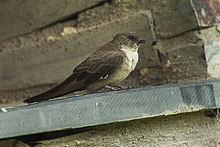
The Eurasian crag martin or just crag martin (Ptyonoprogne rupestris) is a small passerine bird in the swallow family. It is about 14 cm (5.5 in) long with ash-brown upperparts and paler underparts, and a short, square tail that has distinctive white patches on most of its feathers. It breeds in the mountains of southern Europe, northwestern Africa and across the Palearctic. It can be confused with the three other species in its genus, but is larger with brighter tail spots and different plumage tone. Many European birds are resident, but some northern populations and most Asian breeders are migratory, wintering in northern Africa, the Middle East or India.
The Eurasian crag martin builds a nest adherent to the rock under a cliff overhang or increasingly onto a man-made structure. It makes a neat half-cup mud nest with an inner soft lining of feathers and dry grass. Nests are often solitary, although a few pairs may breed relatively close together at good locations. Two to five brown-blotched white eggs are incubated mainly by the female, and both parents feed the chicks. This species does not form large breeding colonies, but is gregarious outside the breeding season. It feeds on a wide variety of insects that it catches with its beak while flying near to cliff faces or over streams and alpine meadows. Adults and young may be hunted and eaten by birds of prey or corvids, and this species is a host of blood-sucking mites. With its large, expanding range and large population, there are no significant conservation concerns involving the species.
This bird is closely related to the other three crag martins which share its genus, and has sometimes been considered to be the same species as one or more of them, although it appears that there are areas where two species' ranges overlap without hybridisation occurring. All four Ptyonoprogne crag martins are quite similar in behaviour to other Old World swallows that build mud nests, and are sometimes subsumed into the larger genus Hirundo, but this approach leads to inconsistencies in classifying several other genera, particularly the house martins. (Full article...) -
The California condor (Gymnogyps californianus) is a New World vulture and the largest North American land bird. It became extinct in the wild in 1987 when all remaining wild individuals were captured, but has since been reintroduced to northern Arizona and southern Utah (including the Grand Canyon area and Zion National Park), the coastal mountains of California, and northern Baja California in Mexico. It is the only surviving member of the genus Gymnogyps, although four extinct members of the genus are also known. The species is listed by the International Union for the Conservation of Nature as Critically Endangered, and similarly considered Critically Imperiled by NatureServe.
The plumage is black with patches of white on the underside of the wings; the head is largely bald, with skin color ranging from gray on young birds to yellow and bright orange on breeding adults. Its 3.0 m (9.8 ft) wingspan is the widest of any North American bird, and its weight of up to 12 kg (26 lb) nearly equals that of the trumpeter swan, the heaviest among native North American bird species. The condor is a scavenger and eats large amounts of carrion. It is one of the world's longest-living birds, with a lifespan of up to 60 years.
Condor numbers dramatically declined in the 20th century due to agricultural chemicals (DDT), poaching, lead poisoning, and habitat destruction. A conservation plan put in place by the United States government led to the capture of all the remaining wild condors by 1987, with a total population of 27 individuals. These surviving birds were bred at the San Diego Wild Animal Park and the Los Angeles Zoo. Numbers rose through captive breeding, and beginning in 1991, condors were reintroduced into the wild. Since then, their population has grown, but the California condor remains one of the world's rarest bird species. By 31 December 2023, the Fish and Wildlife Service had updated the total world population of 561. A May 2024 population estimate of 561 is provided by the non-profit Ventana Wildlife Society on their website. The condor is a significant bird to many Californian Native American groups and plays an important role in several of their traditional myths. (Full article...) -
The pied butcherbird (Cracticus nigrogularis) is a songbird native to Australia. Described by John Gould in 1837, it is a black and white bird 28 to 32 cm (11 to 12.5 in) long with a long hooked bill. Its head and throat are black, making a distinctive hood; the mantle and much of the tail and wings are also black. The neck, underparts and outer wing feathers are white. The juvenile and immature birds are predominantly brown and white. As they mature their brown feathers are replaced by black feathers. There are two recognised subspecies of pied butcherbird.
Within its range, the pied butcherbird is generally sedentary. Common in woodlands and in urban environments, it is carnivorous, eating insects and small vertebrates including birds. A tame and inquisitive bird, the pied butcherbird has been known to accept food from humans. It nests in trees, constructing a cup-shaped structure out of sticks and laying two to five eggs. The pied butcherbird engages in cooperative breeding, with a mated pair sometimes assisted by several helper birds. The troop is territorial, defending the nesting site from intruders. The International Union for Conservation of Nature (IUCN) has assessed the pied butcherbird as being of least concern on account of its large range and apparently stable population. (Full article...) -
The Lesser Antillean macaw or Guadeloupe macaw (Ara guadeloupensis) is a hypothetical extinct species of macaw that is thought to have been endemic to the Lesser Antillean island region of Guadeloupe. In spite of the absence of conserved specimens, many details about the Lesser Antillean macaw are known from several contemporary accounts, and the bird is the subject of some illustrations. Austin Hobart Clark described the species on the basis of these accounts in 1905. Due to the lack of physical remains, and the possibility that sightings were of macaws from the South American mainland, doubts have been raised about the existence of this species. A phalanx bone from the island of Marie-Galante confirmed the existence of a similar-sized macaw inhabiting the region prior to the arrival of humans and was correlated with the Lesser Antillean macaw in 2015. Later that year, historical sources distinguishing between the red macaws of Guadeloupe and the scarlet macaw (A. macao) of the mainland were identified, further supporting its validity.
According to contemporary descriptions, the body of the Lesser Antillean macaw was red and the wings were red, blue and yellow. The tail feathers were between 38 and 51 cm (15 and 20 in) long. Apart from the smaller size and the all-red coloration of the tail feathers, it resembled the scarlet macaw and may, therefore, have been a close relative of that species. The bird ate fruit – including the poisonous manchineel, was monogamous, nested in trees and laid two eggs once or twice a year. Early writers described it as being abundant in Guadeloupe, but it was becoming rare by 1760, and only survived in uninhabited areas. Disease and hunting by humans are thought to have eradicated it shortly afterward. The Lesser Antillean macaw is one of 13 extinct macaw species that have been proposed to have lived in the Caribbean islands. Many of these species are now considered dubious because only three are known from physical remains, and there are no extant endemic macaws on the islands today. (Full article...) -
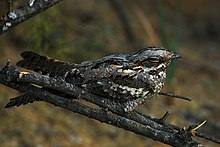
The European nightjar (Caprimulgus europaeus), common goatsucker, Eurasian nightjar or just nightjar, is a crepuscular and nocturnal bird in the nightjar family that breeds across most of Europe and the Palearctic to Mongolia and Northwestern China. The Latin generic name refers to the old myth that the nocturnal nightjar suckled from goats, causing them to cease to give milk. The six subspecies differ clinally, the birds becoming smaller and paler towards the east of the range. All populations are migratory, wintering in sub-Saharan Africa. Their densely patterned grey and brown plumage makes individuals difficult to see in the daytime when they rest on the ground or perch motionless along a branch, although the male shows white patches in the wings and tail as he flies at night.
The preferred habitat is dry, open country with some trees and small bushes, such as heaths, forest clearings or newly planted woodland. The male European nightjar occupies a territory in spring and advertises his presence with a distinctive sustained churring trill from a perch. He patrols his territory with wings held in a V and tail fanned, chasing intruders while wing-clapping and calling. Wing clapping also occurs when the male chases the female in a spiralling display flight. The European nightjar does not build a nest, and its two grey and brown blotched eggs are laid directly on the ground; they hatch after about 17–21 days and the downy chicks fledge in another 16–17 days.
The European nightjar feeds on a wide variety of flying insects, which it seizes in flight, often fly-catching from a perch. It hunts by sight, silhouetting its prey against the night sky. Its eyes are relatively large, each with a reflective layer, which improves night vision. It appears not to rely on its hearing to find insects and does not echolocate. Drinking and bathing take place during flight. Although it suffers a degree of predation and parasitism, the main threats to the species are habitat loss, disturbance and a reduction of its insect prey through pesticide use. Despite population decreases, its large numbers and huge breeding range mean that it is classified by the International Union for Conservation of Nature as being of least concern. (Full article...) -
The white-rumped swallow (Tachycineta leucorrhoa) is a species of bird in the family Hirundinidae. First described and given its binomial name by French ornithologist Louis Pierre Vieillot in 1817, it was for many years considered a subspecies of the Chilean swallow. The species is monotypic with no known population variations. It has a white supraloral streak, or streak above its lores (the region between a bird's eye and nostrils), which can be used to differentiate it from the Chilean swallow. The lores, ear coverts, tail, and wings are black, with white tips on the inner secondaries, tertials, and greater coverts of the wings. The rest of the upperparts are a glossy blue. Its underparts and underwing-coverts are white, in addition to the rump, as the name suggests. The sexes are similar, and the juvenile is duller and browner with a dusky breast.
This species usually builds its nest in holes in trees or dead snags or under or in artificial structures like fence posts and the eaves of buildings. The white-rumped swallow is solitary and nests in distributed pairs during the breeding season. The breeding season is from October to December in Brazil and from October to February in neighboring Argentina. Usually, only one brood with four to seven eggs is laid, although a second one will occasionally be laid. The female incubates the eggs over a period usually between 15 and 16 days, with the fledging usually occurring between 21 and 25 days after hatching.
This swallow is found in Argentina, Bolivia, Brazil, Paraguay, Peru, and Uruguay. Its natural habitats are: (Full article...) -
The willie wagtail (also spelt willy wagtail), scientific name Rhipidura leucophrys, is a passerine bird native to Australia, New Guinea, the Solomon Islands, the Bismarck Archipelago, and Eastern Indonesia. It is a common and familiar bird throughout much of its range, living in most habitats apart from thick forest. Measuring 19–21.5 cm (7+1⁄2–8+1⁄2 in) in length, the willie wagtail is contrastingly coloured with almost entirely black upperparts and white underparts; the male and female have similar plumage.
Three subspecies are recognised; Rhipidura leucophrys leucophrys from central and southern Australia, the smaller R. l. picata from northern Australia, and the larger R. l. melaleuca from New Guinea and islands in its vicinity. It is unrelated to the true wagtails of the genus Motacilla; it is a member of the fantail genus Rhipidura and is a part of a "core corvine" group that includes true crows and ravens, drongos and birds of paradise. Within this group, fantails are placed either in the family Dicruridae, alongside drongos, or in their own small family, Rhipiduridae.
The willie wagtail is insectivorous and spends much time chasing prey in open habitat. Its common name is derived from its habit of wagging its tail horizontally when foraging on the ground. Aggressive and territorial, the willie wagtail will often harass much larger birds such as the laughing kookaburra and wedge-tailed eagle. It has responded well to human alteration of the landscape and is a common sight in urban lawns, parks, and gardens. It is widely featured in Aboriginal folklore around Australia and New Guinea in a variety of roles, from stealer of secrets and liar to a good omen for successful crops. (Full article...) -
The red-winged fairywren (Malurus elegans) is a species of passerine bird in the Australasian wren family, Maluridae. It is non-migratory and endemic to the southwestern corner of Western Australia. Exhibiting a high degree of sexual dimorphism, the male adopts a brilliantly coloured breeding plumage, with an iridescent silvery-blue crown, ear coverts and upper back, red shoulders, contrasting with a black throat, grey-brown tail and wings and pale underparts. Non-breeding males, females and juveniles have predominantly grey-brown plumage, though males may bear isolated blue and black feathers. No separate subspecies are recognised. Similar in appearance and closely related to the variegated fairywren and the blue-breasted fairywren, it is regarded as a separate species as no intermediate forms have been recorded where their ranges overlap. Though the red-winged fairywren is locally common, there is evidence of a decline in numbers.
Bearing a narrow pointed bill adapted for probing and catching insects, the red-winged fairywren is primarily insectivorous; it forages and lives in the shelter of scrubby vegetation in temperate wetter forests dominated by karri trees, remaining close to cover to avoid predators. Like other fairywrens, it is a cooperative breeding species, with small groups of birds maintaining and defending small territories year-round. Groups consist of a socially monogamous pair with several helper birds who assist in raising the young. There is a higher proportion of female helpers recorded for this species than for other species of fairywren. A variety of vocalisations and visual displays have been recorded for communication and courtship in this species. Singing is used to advertise territory, and birds can distinguish other individuals by song alone. Male wrens pluck yellow petals and display them to females as part of a courtship display. (Full article...) -
The red-billed quelea (/ˈkwiːliə/; Quelea quelea), also known as the red-billed weaver or red-billed dioch, is a small—approximately 12 cm (4.7 in) long and weighing 15–26 g (0.53–0.92 oz)—migratory, sparrow-like bird of the weaver family, Ploceidae, native to Sub-Saharan Africa.
It was named by Linnaeus in 1758, who considered it a bunting, but Ludwig Reichenbach assigned it in 1850 to the new genus Quelea. Three subspecies are recognised, with Quelea quelea quelea occurring roughly from Senegal to Chad, Q. q. aethiopica from Sudan to Somalia and Tanzania, and Q. q. lathamii from Gabon to Mozambique and South Africa. Non-breeding birds have light underparts, striped brown upper parts, yellow-edged flight feathers and a reddish bill. Breeding females attain a yellowish bill. Breeding males have a black (or rarely white) facial mask, surrounded by a purplish, pinkish, rusty or yellowish wash on the head and breast. The species avoids forests, deserts and colder areas such as those at high altitude and in southern South Africa. It constructs oval roofed nests woven from strips of grass hanging from thorny branches, sugar cane or reeds. It breeds in very large colonies.
The quelea feeds primarily on seeds of annual grasses, but also causes extensive damage to cereal crops. Therefore, it is sometimes called "Africa's feathered locust". The usual pest-control measures are spraying avicides or detonating fire-bombs in the enormous colonies during the night. Extensive control measures have been largely unsuccessful in limiting the quelea population. When food runs out, the species migrates to locations of recent rainfall and plentiful grass seed; hence it exploits its food source very efficiently. It is regarded as the most numerous undomesticated bird on earth, with the total post-breeding population sometimes peaking at an estimated 1.5 billion individuals. It feeds in huge flocks of millions of individuals, with birds that run out of food at the rear flying over the entire group to a fresh feeding zone at the front, creating an image of a rolling cloud. The conservation status of red-billed quelea is least concern according to the IUCN Red List. (Full article...) -
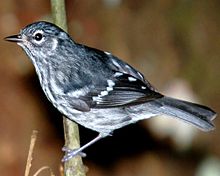
The elfin woods warbler (Setophaga angelae) is a species of bird endemic to Puerto Rico, where it is local and uncommon. Discovered in 1968 and described in 1972, it is the most recently described New World warbler (family Parulidae).
The species name, angelae, is a tribute to Angela Kepler, one of its discoverers. These birds are insectivores, as they feed by gleaning small insects off the habitat leaves.
Due to its small populations and restricted habitats, conservation efforts were begun in 1982 to protect this species, but as of 2005, the warbler was still in need of protection. The species is not in immediate danger as the majority of its habitat is protected forest, but introduced species (such as rats and small Asian mongooses), habitat reduction, and natural disasters represent potential threats to the population. (Full article...) -
The Mascarene martin or Mascarene swallow (Phedina borbonica) is a passerine bird in the swallow family that breeds in Madagascar and in the Mascarene Islands. The nominate subspecies occurs on Mauritius and Réunion and has never been found away from the Mascarene Islands, but the smaller Madagascan subspecies, P. b. madagascariensis, is migratory and has been recorded wintering in East Africa or wandering to other Indian Ocean islands.
The Mascarene martin is a small swallow that has grey-brown underparts becoming white on the throat and lower abdomen, dark grey-brown upperparts and a slightly forked tail. The underparts are heavily streaked with black. It nests in small colonies anywhere with suitably sheltered sites for constructing a nest, such as ledges, buildings, tunnels, caves or amongst rocks. The nest is a shallow cup of twigs and other plant material, and the normal clutch is two or three brown-spotted white eggs. The incubation and fledging times are unknown. The Mascarene martin has a heavy flight with slow wingbeats interspersed with glides, and frequently perches on wires. It feeds on insects in flight, often hunting low over the ground or vegetation. In eastern Africa, open habitats such as deforested areas are frequently used for hunting. A number of internal and external parasites have been detected in this species.
Tropical cyclones can adversely affect populations on the smaller islands, but the Mascarene martin is a locally common bird with an apparently stable population and is classed as a species of Least Concern by the International Union for Conservation of Nature (IUCN). Its legal protection ranges from none on the French overseas department of Réunion to a status on Mauritius as a "species of wildlife in respect of which more severe penalties are provided". (Full article...)
Selected general bird topic

Selected taxon
Phalacrocoracidae is a family of approximately 40 species of aquatic birds commonly known as cormorants and shags. Several different classifications of the family have been proposed, but in 2021 the International Ornithologists' Union (IOU) adopted a consensus taxonomy of seven genera. The great cormorant (Phalacrocorax carbo) and the common shag (Gulosus aristotelis) are the only two species of the family commonly encountered in Britain and Ireland and "cormorant" and "shag" appellations have been later assigned to different species in the family somewhat haphazardly.
Cormorants and shags are medium-to-large birds, with body weight in the range of 0.35–5 kilograms (0.77–11.02 lb) and wing span of 60–100 centimetres (24–39 in). The majority of species have dark feathers. The bill is long, thin and hooked. Their feet have webbing between all four toes. All species are fish-eaters, catching the prey by diving from the surface. They are excellent divers, and under water they propel themselves with their feet with help from their wings; some cormorant species have been found to dive as deep as 45 metres (150 ft). They have relatively short wings due to their need for economical movement underwater, and consequently have among the highest flight costs of any flying bird.
Cormorants nest in colonies around the shore, on trees, islets or cliffs. They are coastal rather than oceanic birds, and some have colonised inland waters. The original ancestor of cormorants seems to have been a fresh-water bird. They range around the world, except for the central Pacific islands. (Full article...)Topics
Anatomy: Anatomy • Skeleton • Flight • Eggs • Feathers • Plumage
Evolution and extinction: Evolution • Archaeopteryx • Hybridisation • Late Quaternary prehistoric birds • Fossils • Taxonomy • Extinction
Behaviour: Singing • Intelligence • Migration • Reproduction • Nesting • Incubation • Brood parasites
Bird orders: Struthioniformes • Tinamiformes • Anseriformes • Accipitriformes • Galliformes • Gaviiformes • Podicipediformes • Procellariiformes • Sphenisciformes • Pelecaniformes • Ciconiiformes • Phoenicopteriformes • Falconiformes • Gruiformes • Charadriiformes • Pteroclidiformes • Columbiformes • Psittaciformes • Cuculiformes • Strigiformes • Caprimulgiformes • Apodiformes • Coraciiformes • Piciformes • Trogoniformes • Coliiformes • Passeriformes
Bird lists: Families and orders • Lists by region
Birds and humans: Ringing • Ornithology • Bird collections • Birdwatching • Birdfeeding • Conservation • Aviculture
Quotes
Resources
Free online resources:
- SORA: The Searchable Online Research Archive (SORA) has decades worth of archives of the following journals: The Auk, The Condor, Journal of Field Ornithology, North American Bird Bander, Studies in Avian Biology, Pacific Coast Avifauna, and The Wilson Bulletin. Coverage ends around 2000. The ability to search all journals or browse exists on the front page.
- Notornis: The Journal of the Ornithological Society of New Zealand covers New Zealand and the South Pacific.
- New Zealand Journal of Ecology: This journal often publishes bird-related articles. Like Notornis, this journal is concerned with New Zealand and surrounding areas.
- Marine Ornithology: Published by the numerous seabird research groups, Marine Ornithology is specific and goes back many years.
- BirdLife International: The Data Zone has species accounts for every species, although threatened species and some key groups have greater detail with others only having status and evaluation.
- Author Index: This is a good source for binomial authorities for taxoboxes.
There is also Birds of North America, Cornell University's massive project collecting information on every breeding bird in the ABA area. It is available for US$40 a year.
For more sources, including printed sources, see WikiProject Birds.
WikiProjects
Selected images
-
Photograph: Charles J. SharpA female giant kingfisher (Megaceryle maxima) feeding on a tilapia on Lake Naivasha, Kenya. From left to right, this composite of four images illustrates: 1. the kingfisher returning to its perch with its prey; 2. smashing it against the post to break its spine; 3. holding it; 4. beginning to consume it.
-
Photo credit: DakomanThe Great White Pelican (Pelecanus onocrotalus) is a large pelican species found from southeastern Europe through Asia and in Africa. At a mass of 10 kg (22 lb), 160 cm (63 in) long and with a 280 cm (110 in) wingspan, it is second in size only to the Dalmatian Pelican.
-
Photograph: BasarThe Green Heron (Butorides virescens) is a heron species of North and Central America; this specimen was photographed at Corcovado National Park, Costa Rica. Adults have a body length of about 44 cm (17 in) and have been known to use tools to attract fish which they then eat.
-
Bald eagle at Bird of prey
-
Rooster at Chicken
-
The Australasian Grebe (Tachybaptus novaehollandiae) is one of the smallest members of the grebe family. Native to greater Australia, New Zealand and nearby Pacific islands, this grebe was first described in 1826.
-
Photo: Fir0002The Musk Lorikeet (Glossopsitta concinna) is a species of lorikeet found in south-central/eastern Australia. It grows to about 22 cm (9 in) long, and can be identified by its red forehead, blue crown and a distinctive yellow band on its wing.
-
Photograph credit: LaitcheThe Daurian redstart (Phoenicurus auroreus) is a small passerine bird from temperate Asia. The adult male has a grey crown and nape, a black face and chin, brownish mantle and wings and a large white wing patch; the chest, lower back and rump are orange, and the tail is black with orange sides. The female is brown above and paler brown below, with an orange rump and tail sides, and a large white wing patch similar to the male's. The species grows to a length of about 15 cm (6 in), and breeds in Manchuria, southeastern Russia, northeastern Mongolia, central China and Korea. A common migratory species, it is not considered to be a threatened species by the International Union for Conservation of Nature.
This picture shows a male Daurian redstart photographed at Daisen Park in Osaka, Japan, in midwinter. -
The Australian Wood Duck (Chenonetta jubata, female shown here) is a dabbling duck found throughout much of Australia. This 45–51 cm (18–20 in) duck looks like a small goose, and feeds on grassland mostly by grazing in flocks. Unusually for a duck, it rarely swims.
-
Photo credit: AngMoThe Eastern Imperial Eagle (Aquila heliaca) is a bird of prey from the Accipitridae family. It is a close relative to the Spanish Imperial Eagle and very similar to the Golden Eagle, but a little smaller and less powerful. The species can be found in Southeast Europe, West and Central Asia, but has nearly vanished from much of its former distribution area of Hungary and Austria.
-
Photo credit: Daniel SchwenA young fluffed up female Blackbird (Turdus merula). Unlike males, who are all black except for a yellow eye-ring and bill, females have brown plumage and a brown beak. Blackbirds are common in woods and gardens over all of Europe and much of Asia south of the Arctic Circle. Females are aggressive in the spring when competing with others for good nesting territory.
-
The Red-headed Finch (Amadina erythrocephala) is a common species of estrildid finch found in Africa. Males have vibrant red heads and chests while the females are duller. Often seen in small flocks on dry savannas, it is a ground feeder which feeds companionably with other species and often visits waterholes.
-
Malurus cyaneus cyanochlamys, juvenile
-
The prothonotary warbler (Protonotaria citrea) is a small songbird of the New World warbler family. It breeds in hardwood swamps in southern Canada and the eastern United States and winters in the West Indies, Central America and northern South America.
-
Photograph: Francis FranklinA male Eurasian bullfinch (Pyrrhula pyrrhula) photographed in Lancashire. This small passerine bird in the finch family was listed in 1758 by Carl Linnaeus in the 10th edition of his Systema Naturae. It is breeds across Europe and temperate Asia, where it is mainly resident, though some birds may migrate. Birds of this species feed mainly on seeds and the buds of fruit trees.
-
Female mallard in mid-flight at Flying and gliding animals
-
Photograph: Olaf Oliviero RiemerThe Inca tern (Larosterna inca) is a species of seabird in the family Sternidae and the only member of its genus. This piscivorous species is restricted to the Humboldt Current and breeds on the rocky coastal cliffs in Peru and Chile, laying one or two eggs which hatch after 4 weeks.
-
Female mallard and ducklings at Burnaby Lake Regional Park
-
Rufous-tailed flycatcherPhotograph: Charles J. SharpThe rufous-tailed flycatcher (Myiarchus validus) is a species of tyrant flycatcher endemic to Jamaica.
-
Photo credit: MdfThe Northern mockingbird (Mimus polyglottos) is the only mockingbird commonly found in North America. It breeds in southeastern Canada, the United States, northern Mexico, the Bahamas, Cayman Islands and the Greater Antilles. This species has occurred in Europe as an extreme rarity.
-
Photograph: David IliffThe Wood Duck (Aix sponsa) is a species of duck, with adults averaging 47 to 54 cm (19 to 21 in) in length with a wingspan of 66 to 73 cm (26 to 29 in). Owing to their attractive colouration, the ducks have often been brought to Britain from their native North America; this specimen was photographed at St. James's Park in London.
Selected bird anatomy topic

1: last free cartilaginous tracheal ring, 2: Trachea 3: first group of syringeal rings, 4: pessulus, 5: membrana tympaniformis lateralis, 6: membrana tympaniformis medialis, 7: second group of syringeal rings, 8: main bronchus, 9: bronchial cartilage
The syrinx (from the Greek word "σύριγξ" for pan pipes) is the vocal organ of birds. Located at the base of a bird's trachea, it produces sounds without the vocal folds of mammals. The sound is produced by vibrations of some or all of the membrana tympaniformis (the walls of the syrinx) and the pessulus, caused by air flowing through the syrinx. This sets up a self-oscillating system that modulates the airflow creating the sound. The muscles modulate the sound shape by changing the tension of the membranes and the bronchial openings. The syrinx enables some species of birds (such as parrots, crows, and mynas) to mimic human speech.
Unlike the larynx in mammals, the syrinx is located where the trachea forks into the lungs. Thus, lateralization is possible, with muscles on the left and right branch modulating vibrations independently so that some songbirds can produce more than one sound at a time. Some species of birds, such as New World vultures, lack a syrinx and communicate through throaty hisses. Birds do have a larynx, but unlike in mammals, it does not vocalize. (Full article...)Selected species
Mourning doves are light grey and brown and generally muted in color. Males and females are similar in appearance. The species is generally monogamous, with two squabs (young) per brood. Both parents care for the young for a time. The species is a prolific breeder, and pairs will often have several broods per year. In warm areas, a pair may have up to six broods a year. Mourning doves eat mainly seeds, including those of both native and introduced plants.
Did you know
- ...that the hood mockingbird will occasionally attack people in an attempt to get fresh water from them?
- ...that prior to the development of binoculars, bird collections, collections consisting of birds and parts of their anatomy, were the dominant method of bird observation and study among ornithologists?
- ...that bird nests range in size from the tiny one inch high cup of some hummingbirds to the massive five meter high mounds of some dusky scrubfowl?
Categories
Related portals
Things you can do
Create requested articles (WikiProject Birds – Article requests):
Do these tasks:
 |
Here are some tasks awaiting attention:
|
More outstanding tasks at the project's cleanup listing, Category:Birds articles needing attention, and Wikipedia:WikiProject Birds/Todo.
Taxonomy of Aves
| Class Aves, divided into superorders, orders, suborders (where indicated), and families. | ||||
|---|---|---|---|---|
|
Associated Wikimedia
The following Wikimedia Foundation sister projects provide more on this subject:
-
Commons
Free media repository -
Wikibooks
Free textbooks and manuals -
Wikidata
Free knowledge base -
Wikinews
Free-content news -
Wikiquote
Collection of quotations -
Wikisource
Free-content library -
Wikispecies
Directory of species -
Wikiversity
Free learning tools -
Wikivoyage
Free travel guide -
Wiktionary
Dictionary and thesaurus
Sources
- ^ Pennsylvania. Dept. of Common Schools; Pennsylvania State Education Association (1911). Pennsylvania School Journal. Pennsylvania State Education Association. p. 115. Retrieved February 7, 2020.


